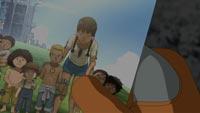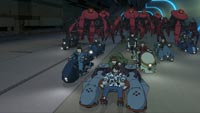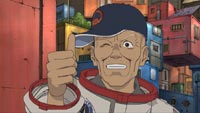If you were to ask me for the best places to find a solid, entertaining, and intelligently written hard science fiction series, an extended advertisement for the 35th anniversary of Nissin’s Cup Noodles would not end up anywhere on the list. However, the fact remains that Freedom, an animated mini-series from Japan, had its origins in just such an exercise in extended product placement, but it is one of the most consistently interesting and entertaining science fiction series in quite some time.
 Directed by rising anime director Shuhei Morita (Kakurenbo – Hide & Seek), Freedom begins on the Moon in the 23rd century. A cataclysm a century earlier had made Earth entirely uninhabitable, leaving a population of settlers on its satellite as the last hope for the continuation of the human race. Rather than go on to colonize Mars as originally intended, the settlers bunker down, creating the idyllic, if totalitarian, mega-city of Eden. However, despite the strict environment, the youth of Eden still engage in reckless rebellion, and it is just such rebellion that establishes Freedom’s central character: the teenaged Takeru. He and his friends—the level-headed Kazuma and the cowardly but mechanically brilliant Biz—spend their free time hot-rodding lunar cycles for dangerous and illegal races with other speed junkies, such as Takeru’s rival Taira. It is just such a race that gets Takeru in trouble with the authorities, leaving him with a trashed lunar cycle and a long community service sentence to work off.
Directed by rising anime director Shuhei Morita (Kakurenbo – Hide & Seek), Freedom begins on the Moon in the 23rd century. A cataclysm a century earlier had made Earth entirely uninhabitable, leaving a population of settlers on its satellite as the last hope for the continuation of the human race. Rather than go on to colonize Mars as originally intended, the settlers bunker down, creating the idyllic, if totalitarian, mega-city of Eden. However, despite the strict environment, the youth of Eden still engage in reckless rebellion, and it is just such rebellion that establishes Freedom’s central character: the teenaged Takeru. He and his friends—the level-headed Kazuma and the cowardly but mechanically brilliant Biz—spend their free time hot-rodding lunar cycles for dangerous and illegal races with other speed junkies, such as Takeru’s rival Taira. It is just such a race that gets Takeru in trouble with the authorities, leaving him with a trashed lunar cycle and a long community service sentence to work off.
 However, it is during his community service duties on the lunar surface that he investigates a meteor impact, only to discover a photograph of a pretty teenaged girl surrounded by younger children at the bottom of the crater. A note—“We are safe. Is anybody out there?”—is scrawled on the back. Takeru soon finds the remains of numerous other care packages scattered around the lunar surface, all of which seem to be from Earth. The smitten Takeru may be driven by hormones as much as a larger sense of scientific curiosity, but he quickly resolves to find the girl in the photo, no matter what the cost. They enlist the help of their friend Alan, an anarchic geezer of an astronaut, only to stir up even more trouble. Before long, the three kids and Alan have uncovered evidence of a massive cover-up, which puts them on the wrong side of the law and on the run from a sudden show of force from Eden’s Guidance Council. It doesn’t take too long before Takeru is left with no alternative but to blast off to Earth in an emergency escape rocket, where he discovers that the Earth is both far better and far worse than he could have imagined.
However, it is during his community service duties on the lunar surface that he investigates a meteor impact, only to discover a photograph of a pretty teenaged girl surrounded by younger children at the bottom of the crater. A note—“We are safe. Is anybody out there?”—is scrawled on the back. Takeru soon finds the remains of numerous other care packages scattered around the lunar surface, all of which seem to be from Earth. The smitten Takeru may be driven by hormones as much as a larger sense of scientific curiosity, but he quickly resolves to find the girl in the photo, no matter what the cost. They enlist the help of their friend Alan, an anarchic geezer of an astronaut, only to stir up even more trouble. Before long, the three kids and Alan have uncovered evidence of a massive cover-up, which puts them on the wrong side of the law and on the run from a sudden show of force from Eden’s Guidance Council. It doesn’t take too long before Takeru is left with no alternative but to blast off to Earth in an emergency escape rocket, where he discovers that the Earth is both far better and far worse than he could have imagined.
The earliest parts of Freedom come off as a beautiful but mundane “How are we getting there?” story, with a well-worn conspiracy theory acting as the prime mover of the plot. We can guess the truth behind the photo well before anybody on screen even considers the possibility, and there isn’t much rhyme or reason given to anyone’s actions, from the main players to the totalitarian Guidance Council of Eden. From the start, one of the best aspects of the show is that it is a “hard” science fiction story, meaning that most of its carefully considered technology feels plausibly real, as does the science underlying the world of Freedom. Other than forgetting to tell us how Eden seems to have Earth-level gravity, Freedom is steeped in realistic and believable science that is used to underscore or advance the plot.
However, during episode 3, the show begins to take sharp left turns at every opportunity, providing a few unexpected twists that are finally punctuated by the launch for Earth. Volume 4 picks up with Takeru on Earth, where he has to contain his surprise and disappointment in order to continue his quixotic quest in a harsh, dangerous, and hauntingly beautiful environment. While the post-apocalyptic ruins of Earth won’t be too surprising, the way Takeru reacts to it and the way the denizens of the Earth react to him are an unexpected delight. Volume 5 is consistently surprising, slowing down the pace to explore Takeru and Biz’s new friends on Earth just long enough to lull you into a false sense of security before launching into an astounding sequence set in the middle of a hurricane. Judging by the trailer to the next volume, the series is also about to take another sharp left turn into brave, new territory. The entire series thus far has also managed to find interesting ways to express its stated theme of freedom, going beyond the obvious setup that the plot immediately suggests.
 A real reason to check out at least one episode of Freedom is the astonishing technical prowess on display in its animation. The series uses a blend of 2-D and 3-D animation techniques to create its fascinating world. Freedom seems to use the same techniques as the earlier SOS! Tokyo Metro Explorers: The Next, using cel-shading 3-D CGI models to simulate traditional hand-drawn anime. The amount of time it takes to catch on, and the fact that I’m still not entirely sure what’s hand-drawn and what’s CGI, is a perfect indicator of how far advanced Freedom is from Tokyo Metro Explorers. In fact, it seems that the only truly hand-drawn elements are the faces, which are wonderfully expressive and show the clear influence of the project’s character and mecha designer, Katsuhiro Otomo. This combination also ensures that pure CGI elements, such as vehicles and some environments, will combine perfectly seamlessly with the characters—a hurdle even the best hand-drawn animation will stumble at. Highlights of this combination can be seen in any of the lunar hot rod races on the first 2 volumes, or in the exciting chase sequences on volume 3, where multi-legged robots chase down fleeing buggies or people. With SOS! Tokyo Metro Explorers: The Next, the reason for doing CGI in a hand-drawn style was not clear. In Freedom, the results are so beautiful that the question never even comes up.
A real reason to check out at least one episode of Freedom is the astonishing technical prowess on display in its animation. The series uses a blend of 2-D and 3-D animation techniques to create its fascinating world. Freedom seems to use the same techniques as the earlier SOS! Tokyo Metro Explorers: The Next, using cel-shading 3-D CGI models to simulate traditional hand-drawn anime. The amount of time it takes to catch on, and the fact that I’m still not entirely sure what’s hand-drawn and what’s CGI, is a perfect indicator of how far advanced Freedom is from Tokyo Metro Explorers. In fact, it seems that the only truly hand-drawn elements are the faces, which are wonderfully expressive and show the clear influence of the project’s character and mecha designer, Katsuhiro Otomo. This combination also ensures that pure CGI elements, such as vehicles and some environments, will combine perfectly seamlessly with the characters—a hurdle even the best hand-drawn animation will stumble at. Highlights of this combination can be seen in any of the lunar hot rod races on the first 2 volumes, or in the exciting chase sequences on volume 3, where multi-legged robots chase down fleeing buggies or people. With SOS! Tokyo Metro Explorers: The Next, the reason for doing CGI in a hand-drawn style was not clear. In Freedom, the results are so beautiful that the question never even comes up.
The only real criticism to be leveled at Freedom is its blatant product placement of Nissin Cup Noodles. There’s always at least one scene somewhere in every episode that features the product prominently and obviously, to the point where we begin to wonder if the producers inserted them as self-aware, Wayne’s World-flavored gags. On reflection, one also wonders if the continued production and consumption of Cup Noodles in Eden sends the message it ought to about Nissin, since it can raise uncomfortable questions about the compromises they’ve had to make to thrive for more than a century under a totalitarian regime. However, the corporate sponsorship is a very small price to pay for such beautiful, expressive, and well-thought out work. If all commercials were this good, we wouldn’t mind watching them.
 Unfortunately, as interesting as Freedom is, it is questionable whether the series really justifies its incredibly high price tag. Each disc of the series contains only one 24-minute episode of the series with no extras other than a translation of the credits. To the joy of anime purists, Freedom doesn’t even come with an English dub track, offering only the original Japanese soundtrack with English subtitles. The lack of extras is especially frustrating, because a good behind-the-scenes documentary on the animation techniques would be most welcome. It’s true that each disc is a DVD/HD DVD hybrid, and I don’t doubt that the series is even more visually stunning in high-definition video. However, this hybrid means that each individual disc has a price tag that won’t induce sticker shock as much as a full-on price coronary. The fact that it has ended up on the losing side of the high-definition DVD format wars doesn’t help, either. After the concluding two volumes are released, the best thing that Bandai could do is to repackage the entire series on one extended-length standard DVD, which would no doubt still retail for less than half the cost of any volume of Freedom released so far.
Unfortunately, as interesting as Freedom is, it is questionable whether the series really justifies its incredibly high price tag. Each disc of the series contains only one 24-minute episode of the series with no extras other than a translation of the credits. To the joy of anime purists, Freedom doesn’t even come with an English dub track, offering only the original Japanese soundtrack with English subtitles. The lack of extras is especially frustrating, because a good behind-the-scenes documentary on the animation techniques would be most welcome. It’s true that each disc is a DVD/HD DVD hybrid, and I don’t doubt that the series is even more visually stunning in high-definition video. However, this hybrid means that each individual disc has a price tag that won’t induce sticker shock as much as a full-on price coronary. The fact that it has ended up on the losing side of the high-definition DVD format wars doesn’t help, either. After the concluding two volumes are released, the best thing that Bandai could do is to repackage the entire series on one extended-length standard DVD, which would no doubt still retail for less than half the cost of any volume of Freedom released so far.
One can only hope that Bandai does exactly that, because Freedom is definitely a series worth seeing. It succeeds on almost every level, from its jaw-droppingly beautiful visuals to its intriguing story and pointed social commentary. Even so, the cost and format selected for its North American release virtually ensures that it will never find the audience that it deserves, which is a real shame. It’s often said that freedom isn’t free; at the very least, it’s true that freedom is not and should not be too easy to gain and is never easy to keep. This is fine when discussing freedom as an abstract concept, but is a decided detriment when you’re talking about a home video product.



